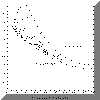The data is from runs 20140 and 20111 (1 file) for a total of 547.291 triggers.
The photon hits were taken from the TAGR bank using the ones with status 7 and 15. For
status 15 hits (that is multiple hits on the tagger) the photon into into the ST
time distribution (+/- 5ns) were considered.
With these cuts the total number of reconstructed photons is 255.960 (47%).
Only the PART bank was considered with the condition that the quality factor for the
neutrals different from 999999.
The good events are 34% of the total number of triggers.
 |
Missing mass spectrum for gamma d -> p X(n)
Black Line = all (fast) proton events;
Red Line = (Black line)
with proton TBT vertex from the target region
Green Line = (Red line) with
only one charged track in the final state; |
 |
Reconstructed particles from P.I.D. in the three cases chown
before. In the first two plots the presence of deuterons is not possible since the events
already has an identified proton. |
 |
Missing mass for gamma d -> p X(n) versus teta in
the CLAS system. The photodisintegation events are along the line corresponding to the
neutron mass. The diagonal line starting from the ~1.2 GeV corresponds to events in which
the final state is composed by a fast nucleon which had interaction with the gamma and a
pion (the other nucleon is not detected). This is in agreement with the MC simulations. |
 |
Missing mass for gamma d -> p X(n) versus
detected proton momentum. Protons coming from the photodisintegration channel are at small
teta and large p. |
 |
Missing Mass for gamma d -> p X(n) versus photon
energy. |
 |
Proton momentum as a function of teta angle in CLAS for
photodisintegration protons. The solid lines come from cinematic limits corresponding to
the two extreme gamma energies. |
 |
Pi0 invariant mass spectra. |
 |
Momentum of the 2gamma invariant mass as a function of the
teta angle of the 2 gammas in the CLAS system. The solid line represents the maximum of
the Pi0 momentum distribution (calculated from (m(pi0)^2)/(8 P(pi0) E(pi0))
/ ( sen^3(teta/2) * sqrt(sen^2(teta/2)-(m(pi0)/E(pi0))^2)) )) as a function of
teta. |







